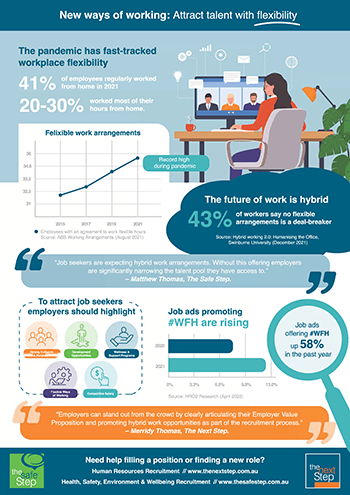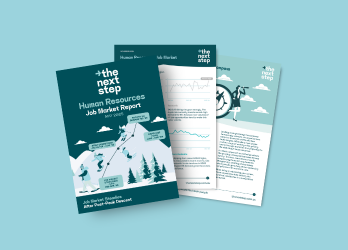Hybrid Work 2.0 & flexible ways of working
Flexibility is the number one requirement for HR professionals seeking work. Almost 90% of job seekers we speak to expect access to hybrid ways of working and are highly attracted to wellbeing and business agility.
Employers are having to sharpen their EVP and champion flexibility in order to attract and retain staff. Download our new ways of working snapshot below or read on to learn more.

The rise of hybrid work models
The pandemic has transformed the way we work. fast-tracking hybrid ways work models. Over the past 2-years face-to-face meetings and office-based work have largely been replaced by video conferences and digital collaboration tools. In 2021 41% of Australian employees regularly worked from home , up from 30% in 2015*.
Productivity has in many respects thrived in an online environment, but organisations are carefully balancing business agility and employee wellbeing with waning culture and opportunities for innovation.
Whilst many employers are offering flexibility as a way of attracting and retaining staff, not all workplaces are able to offer hybrid work models. In some cases the gap between employer and employee expectations is creating tension.
Hybrid work is here to stay
In 2022 hybrid work has become a ‘must have’ for jobseekers. Having got used to working from home during the early years of the pandemic, many are now reluctant to give up their new-found freedoms.
9 out of 10 HR professionals we speak to are now expecting hybrid work opportunities. A Swinburne University study recently found that 43% of workers say flexible work arrangements are a deal breaker when it comes to accepting a new job.^
“Job seeker are expecting hybrid work arrangements. Without this offering employers are significantly narrowing the talent pool they have access to,” explains Workplace Health and Safety Recruitment Consultant Matthew Thomas.
Workplaces will need to continue to adjust to changing needs. HR departments will be in the driving seat of this transformation, they need to be one step ahead of the curve.
“Employers are meeting workforce needs by providing a better work-life balance, greater autonomy, and allowing employees independence to focus on quality over quantity,” says The Next Step’s Senior Consultant Vicki Treeby.
Hybrid 2.0 - how hybrid models have changed
In 2020 and 2021 we saw relatively strict hybrid models. A common offering was a clear 60/40 split (with 60% of time spent in the office and up to 40% spent working from home).
In 2022 workplaces have taken a more fluid approach. Business leaders are remaining open to people’s changing circumstances and are working around local outbreaks, health concerns, school shutdowns and cost of living expenses.
Instead of short-term reactionary measures, Employers are considering how to get hybrid right for the long-term. Hybrid 2.0 must be thoughtfully designed to suit individual needs and the new world of work. Everyone is different.
Organisations are focusing on ways of incentivising, rather than ‘forcing’ staff back into the office. A focus on social activities (Thursday is the new Friday), a move to revitalise office spaces and subsidised travel expenses are some activities designed to attract workers back to the workplace.
Be clear about your offering
To attract and retain top talent in an extremely tight job market, employers need to promote their hybrid offering. In the past year, we’ve seen job advertisements mentioning ‘work from home’ rise 58%# , but despite this increase many organisations still aren’t highlight the benefits they offer clearly enough
Job seekers are currently looking for the ‘complete package’ Flexible ways of working, development opportunities and culture are so important that they often trump salary in importance. We have even had experience placing people in ‘difficult to fill’ roles by offering 100% remote work – something that would have been unheard of a few years ago.
Paint a picture that attracts and retains workers... are you a stable blue-chip, an exciting start-up or a have a clear environmental and social governance policy? Highlight what differentiates your organisation and makes it a good place to work.
Remain flexible about flexibility
Flexbile working models should be designed to meet individual needs and 'ideal flexibility' will vary between organisations. A co-design process can help give employees a voice in designing a workplace that works for them.
Not every employer is able to (or wants to) offer hybrid ways of working. Industries such as manufacturing, transport, hospitality and health require employees to be on-site, operating equipment or face-to-face with customers.
Operational constraints may limit work from home opportunities, but other forms of flexibility can be offered in place.
8 ways to offer workplace flexibility when hybrid work isn’t possible
1. Varied Hours of Work
A standard work day doesn’t have to be strictly 9 to 5. Allowing flexible start and finish times can allow pet owners to walk dogs during daylight hours, accommodate a hobby or help working parents with school drop-offs or pick-ups.
2. Compressed Work Week/Fortnight/Month
Employees work the same number of hours across a shorter period of time e.g. a forty-hour week could be broken into four 10-hour days instead of five 8-hour days. A condensed 9-day fortnight is another popular alternative.
3. Flexitime
'Flexitime’ allows employees to meet fluctuations in workload and balance them with personal needs. Extra hours can be
accrued over a period of days or weeks and reclaimed as time off in lieu.
4 . Drop-Down Periods
Businesses can support working parents by allowing them to drop-down to part-time hours during school holidays or pandemic-related shut-down periods.
5. ‘Work From Home’ Duties
Even when the bulk of a role requires a worker to be on-site, there may still be occasional duties that can be carried out
remotely e.g. scheduling, reporting or ongoing professional development.
6. Varied Location of Work
Can an employee based in your QLD office support form a part of your NSW team? Flexibility of workplace location can open-up a broader pool of talent for new roles and provides support for existing staff who wish to move.
7. Part-Time & Job-Share Opportunities
Whilst not necessarily flexible in their own right, the availability of high-quality, well-paid part time or job-share roles can help your workforce to achieve a greater work/life balance.
8. Extended Leave
Some people may benefit from taking a sabbatical from work to attend to personal needs. Employees may wish to undertake further study, re-charge their batteries with a career-break or take extended leave to care for a loved-one. Providing employees with extended paid or unpaid leave can help retain existing staff. .
How we can help
We are well placed to advise organisations about how to position a role in order to attract top HR talent. If you are looking for support in this area, please feel free to give your Next Step consultant a call to discuss.
Merridy Thomas is Director of The Next Step, NSW. She specialises in senior HR talent acquisition across generalist and specialist streams. She supports Executive HR professionals in finding the best opportunities across Sydney and NSW with a particular focus on change and transformation roles.
Sources
* Working Arrangements (August 2021), Australian Bureau of Statistics
^ Hybrid working 2.0: Humanising the Office, Swinburne University (December 2021)
# Working From Home – The New Normal’ - HR02 Research (April 2022)
Author : Merridy Thomas Date published : 11/05/2022



